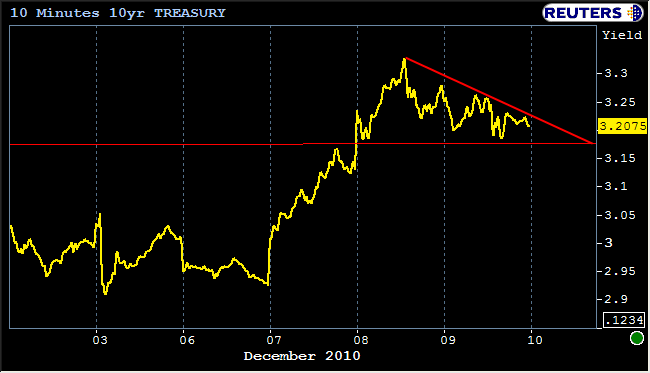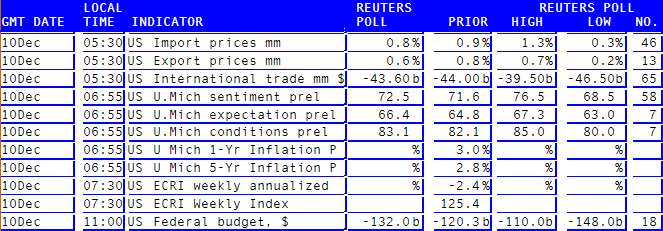Today we saw an aggressively bid 30 year bond auction give benchmarks a boost but positive progress eventually stalled at a long term technical resistance level. When short term rallies are capped by long term technical levels, we have to stop and prepare ourselves for the possibility that current market rates will be with us into 2011. That means December closings need to be treated with a tactical market approach.
The MBS chart is complicated by the roll today so we're gonna K.I.S.S and use a 10yr TSY note to illustrate directionality.
The long horizontal line is our long term technical resistance level. Bond-bulls would like to see yields move back under that line. After yesterday's highs, we can see yields racheting back down toward that line, suggesting a breakout either late tomorrow or next week. AQ has described this formation as the market "storing energy" for a bigger move. It is called a "flag or pennant formation", which when viewed on a longer run interval implies CONTINUATION is looming.
Plain and Simple: CONTINUATION as in the market is storing energy and is about to make a bigger move! One way or another, we are due some volatility!
If we weren't willing to chalk up this volatility to a year-end lack of trading liquidity, we might roll over on our longer term outlook for a retest of lower yields. So in the big picture, a breakout doesn't necessarily mean anything. But in the short term, as in those who are engaged in a "tactical market approach", we would plan our lock/float strategy around two things. 1. This long term technical resistance line and 2. How/if bargain buyers react to volatility in the day's ahead.

We might be stuck in the mud or we might not be stuck in the mud. Either way I think long term resistance in 10s at 3.17% will dictate directionality in the day's ahead. If we break it and MBS prices rally, we'd set our "best ex" loan pricing targets as follows: 4.75% is your base. You don't want to lose 4.75% This is your line of demarcation. Anything attractive below 4.75% should be considered sacred. Especially float down friendly 4.50% par pricing.
A close examination of loan pricing shows that we are indeed being "nudged" toward loan rates that can be pooled in 4.5 coupon MBS. Lenders are effectively doing this by gradually shifting better execution to those rates that correspond with 4.5 coupons as opposed to their next lowest neighbor on the rate sheet. 4.75 vs. 4.625 is a good example of this as we can see float-down there getting more expensive day over day. Check out AQ's loan pricing comparison table below...
On a bright note.... we have been watching origination flows as closely as possible, and as far as we can tell, the 4.0 MBS coupon is still the hedging coupon of choice. The caveat we must add to that observation is we don't know how many lenders are still actively filling 4.0 loan buckets. We do know that 4.75% can be pooled into 4.0s or 4.5s though. This gives lenders some flexibility in the event MBS prices continue to fall into the new year. REMEMBER: 4.75% is the line of demarcation. Anything below 4.625% should be considered sacred. Especially float down friendly 4.50% par pricing.
--------------------------------------------------------
EXPLANATION OF LOAN PRICING COMPARISON
Buydowns are the cost of floating down to the next lowest note rate. Buydown costs are matched to the note rate in the same row. For example, the first number in the buydown column is .416%, this is the cost to float down from 5.00% to 4.875%, as a percentage of the loan amount. This is important because it helps an originator determine the best execution rate/points combination for a borrower who has a good idea of how long they intend to live in their home (breakeven on points paid vs. monthly payment savings). In the Buydown Delta column, red is cheaper. Black is more expensive.
The pricing change column is a direct rebate comparison of pricing today vs. pricing yesterday. Red is worse. Black is better.
The BE v M column shows you how margin is changing. RED means more margin. Black means less bps are baked into pricing.

Showing up to help decide what direction stored energy is released....Econ data and preparations next week's FOMC (and overnight momentum)!
Econ data does become a bit more important though, mostly because legislative votes are a non-issue and Treasury supply behind us. Here's the run-down:

Bottom line, if you gotta get out, look for opportunities to "get safe" in the short term, and then get safe. This is still very much about battening down hatches and weathering the storm. Even if we gain some rally traction in December, we're skeptical of how willing lenders will be to add production into the brunt of the holiday season. Hello wider primary/secondary pricing spreads....





